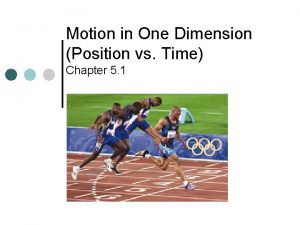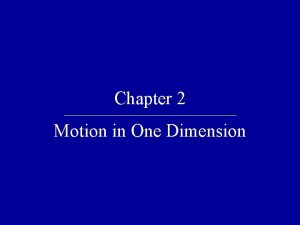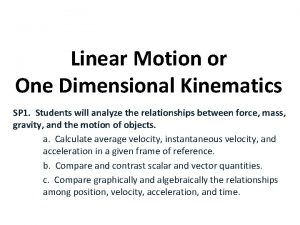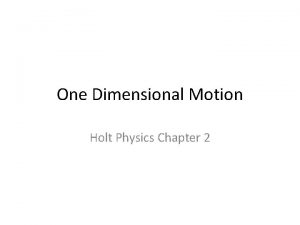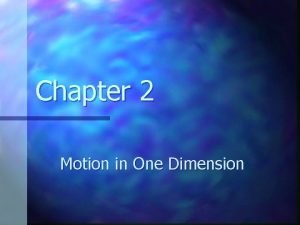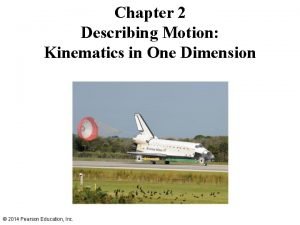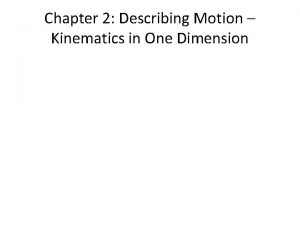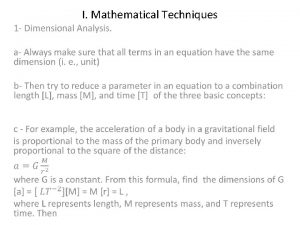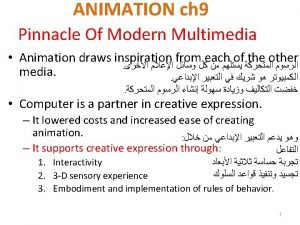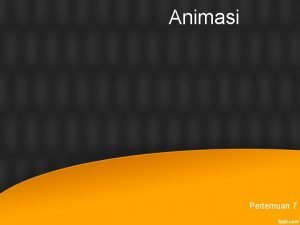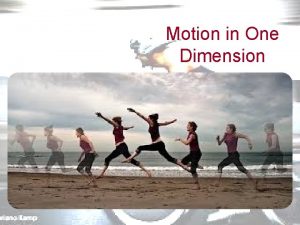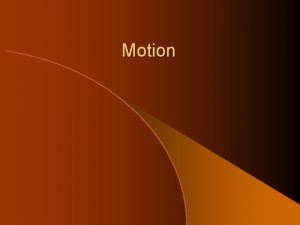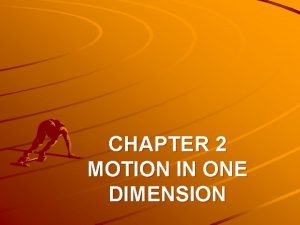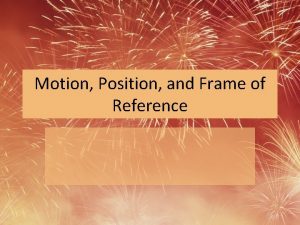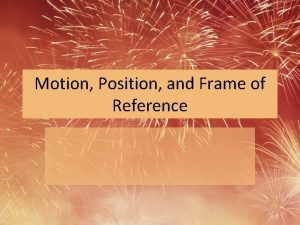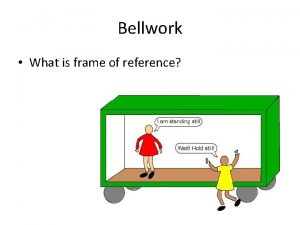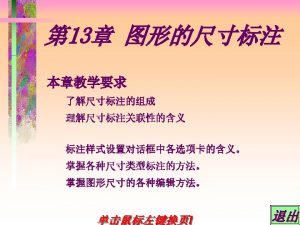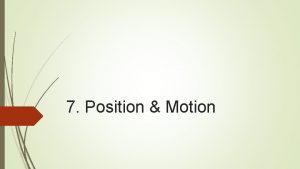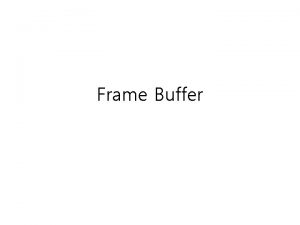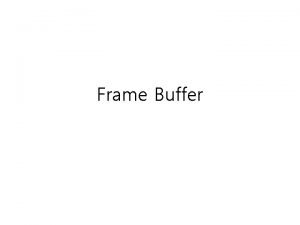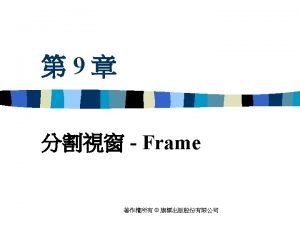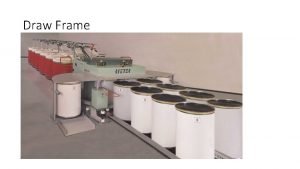Motion ONE DIMENSION POSITION FRAME of REFERENCE 1














- Slides: 14

Motion ONE DIMENSION POSITION: FRAME of REFERENCE -1 0 1 2 3 4 5 TIME: STARTING POINT, define "t=0" +X

Motion ONE DIMENSION MOTION IS RELATIVE Train motion Toy train motion A boy sits in a moving train and plays with his toy train. Red arrows represent motion of the train and the toy train as seen by a man on the platform. Draw an arrow representing a motion of the toy train as seen by a) the boy b) the train driver c) the toy train driver

Distance & Displacement DISTANCE DISPLACEMENT The total length of the path the object has traveled The net CHANGE in position An object starts at +1, moves right to x=+3, moves back left to +2, then finally moves right to +5, as shown. -1. The 0 1 2 overall displacement is The overall distance is 3 4 5 Δx = 5 – 1 = +4 m 2+1+3=6 m +X

Distance & Displacement An object goes from one point in space to another. After it arrives at its destination, the size of its displacement is: A: could be smaller or larger B: always equal to C: either greater than or equal to D: either smaller than or equal to than the distance it traveled.

Speed and Velocity Speed scalar: magnitude Velocity vector: magnitude and direction

Speed and Velocity Average Speed = total distance elapsed time Average Velocity = total displacement elapsed time scalar vector

The cars started simultaneously at dot on the left and move to the right. The dots represent the locations of each car every second. Car 1 Car 2 1. Where the cars ever next to each other? 2. Choose a reference frame associated with car 1. If there were a passengers in car 1, how would they describe the motion of car 2? 3. Choose a reference frame associated with car 2. If there were a passengers in car 2, how would they describe the motion of car 1?

Graphical representation Motion Diagram to represent, visualize and analyze motion 1. Draw dots to represent the positions of the object at equal time intervals = - 2. Point arrows in direction of motion, and use the relative length to indicate how fast the object is moving 3. Draw arrow to indicate how the arrows are changing.

Graphical representation Motion Diagram A car stops for a red light. When the light turns green, the car moves forward for 3 s at increasing speed. The car then travels at constant speed for another 3 s. Finally, when approaching another red light, the car steadily slows to stop during the next 3 s. Draw a motion diagram that describes this process t=0 t=3 s t=6 s =0 t=9 s

Graphical representation Graphs S 0 Clock reading t (s) Position S (m) t 0 = 0 t 1 = 20 t 2 = 40 t 3 = 60 t 4 = 80 t 5 = 100 t 6 = 120 S 0 = 0 S 1 = 100 S 2 = 200 S 3 = 300 S 4 = 400 S 5 = 500 S 6 = 600 S, m y = kx +b 600 S = kt +b 500 S = 5 t +0 400 300 v=5 m/s 200 100 0 20 40 60 80 100 120 t, s

Graphical representation Graphs 0 Clock reading t (s) Position S (m) t 0 = 0 t 1 = 20 t 2 = 40 t 3 = 60 t 4 = 80 t 5 = 100 t 6 = 120 S 0 = 640 S 1 = 500 S 2 = 360 S 3 = 220 S 4 = 80 S 5 = -60 S 6 = -200 640 S Describe in words the motion of the biker: 1. In what direction does he go? 2. What is the starting point of his motion? 3. What is his speed? 4. Does it change?

Graphical representation Graphs S 0 Clock reading t (s) Position S (m) t 0 = 0 t 1 = 20 t 2 = 40 t 3 = 60 t 4 = 80 t 5 = 100 t 6 = 120 S 0 = 640 S 1 = 500 S 2 = 360 S 3 = 220 S 4 = 80 S 5 = -60 S 6 = -200 Construct a position-versus-clock reading graph for the bike trip. Write a function of the graph. S, m S = 640 - 7 t 600 500 400 300 200 100 0 20 40 60 80 100 120 t, s

Quiz Question An ant crawling along the floor follows a semi-circular path, going half way around the circumference of a circle of radius R. The distance traveled, and the displacement of the ant, are respectively: A: p R and p R B: 2 R and p R C: p R and 2 R D: p R and zero E: none of these Explain your answer! The circumference is 2 p. R

Homework (due Wednesday) Chapter 2. Problems (page 49) Section 2. 2 Velocity # 2, 5, 6, 9, 12, 16, 17, 18 (make sure that you can solve all of the problems in this section!)
 To describe a position in more than one dimension
To describe a position in more than one dimension Motion in one dimension quiz
Motion in one dimension quiz What is negative velocity on a graph
What is negative velocity on a graph Chapter 2 motion in one dimension answer key
Chapter 2 motion in one dimension answer key Holt physics chapter 2
Holt physics chapter 2 Free fall motion in one dimension
Free fall motion in one dimension Motion in one dimension
Motion in one dimension Describing motion kinematics in one dimension
Describing motion kinematics in one dimension Describing motion kinematics in one dimension
Describing motion kinematics in one dimension Motion in one dimension
Motion in one dimension Motion in one dimension
Motion in one dimension First position second position third position
First position second position third position Frame by frame animation programs
Frame by frame animation programs Pengertian animasi frame by frame
Pengertian animasi frame by frame Risanuri hidayat
Risanuri hidayat
